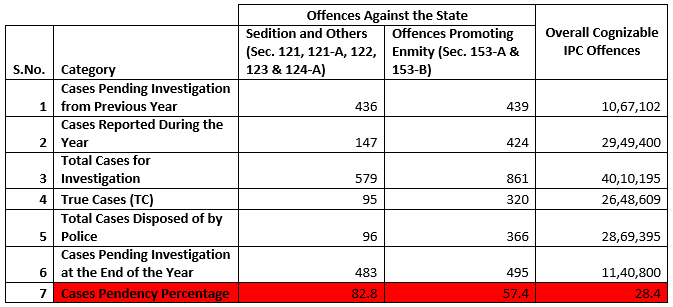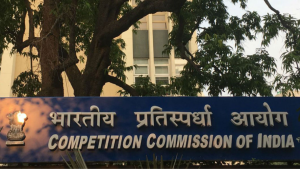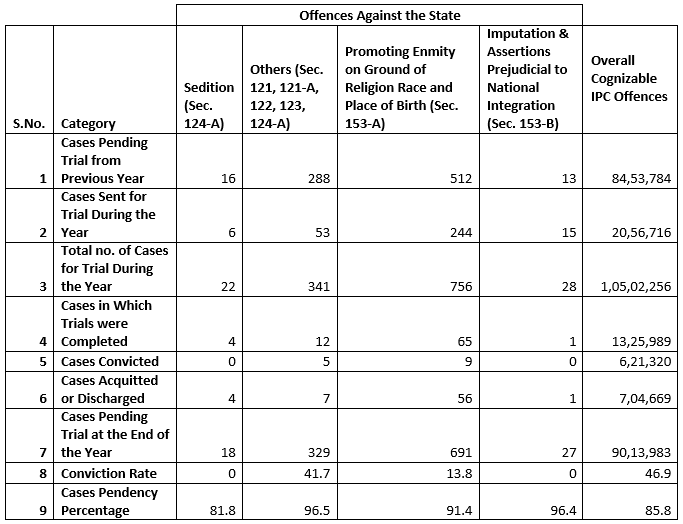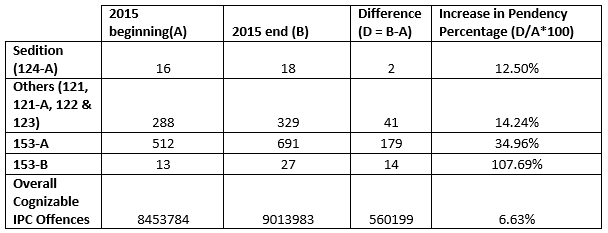

Analysing Access to Justice in “Offences Against the State”
- January 11, 2017
- Rishabh Sharma
‘Offences Against the State’ by their very nature immediately attract State attention. Over the last few years there have been multiple incidents that have been reported under this category. Given the propensity of the crime, ‘Offences Against the State’ entail long and harsh punishments. The burden of prosecution in these cases is on the State and it acts as the biggest repeat player in the criminal justice system. Therefore it becomes imperative to study to the role and the responsibility that the State plays in trials of such offences. It is expected that the State would participate in the legal proceedings with the utmost vigour and a sense of priority to ensure justice is done in a timely manner, and the wrongly incarcerated innocent is released at the earliest.
In this blog post we analyse the efficiency and the efficacy i.e. the promptness and the correctness with which the State pursues these matters. For this study we have looked at the data provided by NCRB in ‘Crime in India’, 2015 in Chapter 21 ‘Offences Against the State’, Chapter 4 ‘Disposal of Cases by Police & Courts’ and Additional Table on ‘Data Analysis on IPC Crime-heads Under Various Heads during 2015’.
As detailed in Chapter 21 of Crime in India, 2015, the relevant IPC offences are as follows: –
- ‘Sedition’ i.e. Section 124-A
- ‘Waging, or attempting to wage war, or abetting waging war, against the Government of India’ – Section 121, ‘Conspiracy to commit offences punishable by Section 121’ – Section 121-A, ‘Collecting arms, etc., with intention of waging war against the Government of India’ – Section 122 and ‘Concealing with the intent to facilitate design to wage war’ – Section 123, are collectively referred to as ‘Others’
- ‘Promoting enmity between different groups on grounds of Religion, Race, Place of Birth, Residence, Language, etc. and doing acts prejudicial to maintenance of harmony’ i.e. Section 153-A
- ‘Imputations, assertions prejudicial to national integration’ i.e. Section 153-B
For the purpose of evaluation, a comparison has been drawn between ‘Offences Against the State’ and the ‘Overall Cognizable IPC Offences’ reported in 2015. The table below gives the number of Cases Registered (CR), Cases Chargesheeted (CCS), Cases not Chargesheeted but Final Report Submitted (CNCFR) and the Chargesheeting Rate (CSR) under each offence type comprising of ‘Offences Against the State’ :-
Table 1: Data recorded by NCRB on ‘Offences Against the State’
NCRB defines ‘True Cases’ (TC) as the summation of Cases which are Chargesheeted and the Cases which aren’t Chargesheeted but a Final Report Submitted (TC = CCS + CNCFR). ‘Chargesheeting Rate’ (CSR) is calculated against the number of True Case (CSR = CCS/TC). The table below contains data on above listed parameters for ‘Overall Cognizable IPC Offences’ in 2015:-
Table 2: Data on Overall Cognizable IPC Offences
On comparison of Table 1 and Table 2, we see that the Chargesheeting Rate for the two is similar (76.6% and 77.7%). For ‘Sedition’ and ‘Others’ the Chargesheeting Rate is 62.1%, i.e. 15.6% point lower than that for Total Cognizable IPC Offences.
The following Tables lists the data on disposal of Cases by the Police and increase pendency in 2015 in ‘Offences Against the State’ and ‘Overall Cognizable IPC Offences’:-
Table 3: Data on Disposal of Cases by Police

Table 3.1: Cases with Pending Police Investigation
For ‘Sedition’ and ‘Others’ the number of cases pending from previous years = 436. However, only 96 cases were disposed of by the Police. Supposing no new cases were instituted in 2015, even then to clear the backlog of 436 cases at the rate of 96 cases a year it would take the Police a little over 4 years and 6 months to completely get rid of all the pending cases. On the other hand for ‘Overall Cognizable IPC Offences’ the number of cases pending at the Police end from previous years = 10,67,102, and 28,69,395 cases were disposed of by the Police in 2015. At this rate, if no new cases were instituted during the year, the Police would dispose of all the pending cases in approximately 4 and a half months time.
The Case Pendency Percentage for ‘Sedition’ & ‘Others’ is as high as 82.8%, for 153-A & 153-B it is 57.4%, where as for Overall Cognizable IPC Offences it is 28.4%. On comparing the increase in case pendency as given in Table 3.1 we find that the pendency at the end of the year for ‘Offences Against the State’ has increased by 11.77% with respect to the pendency at the year beginning. Whereas, the increase in pendency at the year end for ‘Overall Cognizable IPC Offences’ is 6.91% w.r.t. pendency at the beginning of the year. This is reflective of a relaxed attitude of the State towards the conduct and the closure of investigation in ‘Offences Against the State’. Even with much lesser number of such cases, the pendency percentage at the end of the Police is alarming.
Once the chargesheet is filed by the Police in a case then the trial begins in a Court. The tables attached below contain data on Disposal of Cases by the Courts and the increase in pendency in the year 2015 in the specified offences:-
Table 4: Data on Disposal of Cases by Courts
Table 4.1 Cases with Pending Trial by Courts
As per Table 4, the trial was completed in 16 cases falling under ‘Sedition’ and ‘Others’. It accounts for 4.41% of the 363 cases sent for trial during the year 2015. Similarly 66 cases under 153-A and 153-B were disposed off by the Courts, which is 8.42% of the 784 cases sent for trial. Collectively, 82 trials under ‘Offences Against the State’ were completed i.e. 7.15% of the total 1147 cases sent for trial. However, the Courts disposed off 13,25,989 cases pertaining to Cognizable IPC Offences i.e. 12.63% of the total number of cases for trial during the year. If we compare the increase in case pendency at the year end w.r.t year beginning then we find that increase in pendency for ‘Offences Against the State’ is 28.47%. However this number for ‘Overall Cognizable IPC Offences’ is 6.63%.
This suggests that the Courts are unable to dispose the cases pertaining to ‘Offences Against the State’ at a comparable rate as ‘Overall Cognizable IPC Offences’. This is interesting because the disposal rate of the Courts for Cognizable IPC Offences is anyway quite low (12.63%) and for ‘Offences Against the State’ it is even lower (7.15%).
Conviction is reflective of successful prosecution and the correctness of a claim or a challenge made by the State. Let us look at the number of cases which resulted in conviction in 2015 for ‘Offences Against the State’. As per Table 4, none of the 4 Sedition cases disposed off resulted in conviction. With 41.7% as the conviction rate, 5 cases falling under ‘Others’ led to conviction out of the 12 trials that were completed. Conviction rate for 153-A offence is 13.8% and for 153-B it is 0.0%. Collectively 82 trials pertaining to ‘Offences Against the State’ were completed. Out of these 82, only 14 cases resulted in conviction with the combined conviction rate of 17.07%. However for Overall Cognizable IPC Offences the conviction rate is 46.9%. This shows in 83% of the cases under ‘Offences Against the State’ the courts do not find merit in the State’s claim.
On comparing the performance of the Police and the Courts we observe:-
- Both are unable to dispose of the cases falling under ‘Offences Against the State’ at the same rate as ‘Overall Cognizable IPC Offences’.
- For Courts the increase in Pendency Percentage at the year end for ‘Offences Against the State’ is 28.47% and for Police it is 11.77%. This indicates that the Courts are taking longer than the Police to decide these matters. Though for ‘Overall Cognizable IPC Offences’ the increase in pendency in case of courts is relatively lesser than that for the Police.
On the basis of the above analysis we can conclude that the state often goes overboard in Case Registration and levelling of Charges. In the year 2015, 1179 individuals were arrested by the Police for alleged ‘Offences Against the State’, however only 16 persons were convicted by the Courts. With very low disposal rate at the end of the Police and the Courts, the cases tend to get dragged for a long time before a final decision is taken. Given the long investigations, low chargesheeting rate, lengthy trials and much lower conviction rate, it seems the process of pendency itself is used as a weapon of suppression by the State to harass and punish people accused of such offences.
[ReviewDisclaimer]

Rishabh Sharma
DAKSH-CLPG Research Fellow at Centre for Constitutional Law, Policy and Governance (CLPG), NLU, Delhi.
RECENT ARTICLES


Testing the Waters: Pre-Implementation Evaluation of the 2024 CCI Combination Regulations

Not Quite Rocket Science

Administration of justice needs an Aspirational Gatishakti

-
Rule of Law ProjectRule of Law Project
-
Access to Justice SurveyAccess to Justice Survey
-
BlogBlog
-
Contact UsContact Us
-
Statistics and ReportsStatistics and Reports
© 2021 DAKSH India. All rights reserved
Powered by Oy Media Solutions
Designed by GGWP Design




